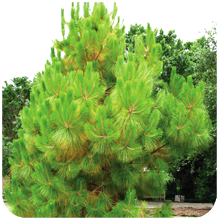
Pinus roxburghii tree can reach 25-30 m height, sometimes 40-50 m and a diameter of 1 to 1.4 m, rooting soil is variable depending on which vegetates; the stem less straight than the other resinous bark ritidom form a thick, gray. Its wood is dark brown, very durable. Leaves are aciforme, 4 cm long, grouped together by two. Tapered cones, stems, or gray color and a length of up to 8 cm. Apophysis is rhombic with umbellic nemucronat. Crown initially pyramidal becomes older tabular irregular branched branches.
Chemical composition – Pinus roxburghii is known for a rich source of terpenoids, flavonoids, tannins, xanthones. The bark contains hexacosylferulate, 1,5-dihydroxy-3,6,7-trimethoxy-8-allyloxy xanthene, 1-hydroxy-3,6-diinethoxy-2-β-D-glucopyranoxanthone, friedelin, cetyl alcohol, b-sitosterol, taxifolin, quercetin, catechin, kaempferol, rhamnetin, 3,4-dihydroxybenzoic. acid, 3,4-dihydroxycinnamic acid, pinosylvin, pinoresinol, resin acid, sterols, gallocatechin and tannins. The major compounds were identified as caryophyllene, 3-carene, α-humulne, α-pinene and α-terpeniol. Pinus roxburghii is extensively used for its resin which is mainly composed of car-3-ene, pinene, longifolene, camphene, limonene, α-terpinene, α-terpineol, d-borneol and dl-camphor.
Properties – Antilithiasic, urinary inflammatory, urinary, pulmonary and liver antiseptic, antitussive, bacteriostatic, bronchodilator, soothing, adrenal stimulant, tonic, nervous system tonic, aphrodisiac, asthmatic, anxiolytic, sedative, antirheumatic.
Recommendation – In all respiratory diseases, bronchitis, tracheitis, pneumonia, tuberculosis, asthma, flu (colds), urinary disorders (cystitis, prostatitis lower) infections, in general, gallstones, weakness, rickets, gastralgia, intestinal pain, diseases of horses general respiratory, lung, influenza, sinusitis, rhinitis, chronic rhinitis, asthma, hyperhidrosis, rheumatism, gout, frigidity, impotence, anxiety.
This plant is incorporated in natural remedy NON DOLOR.




